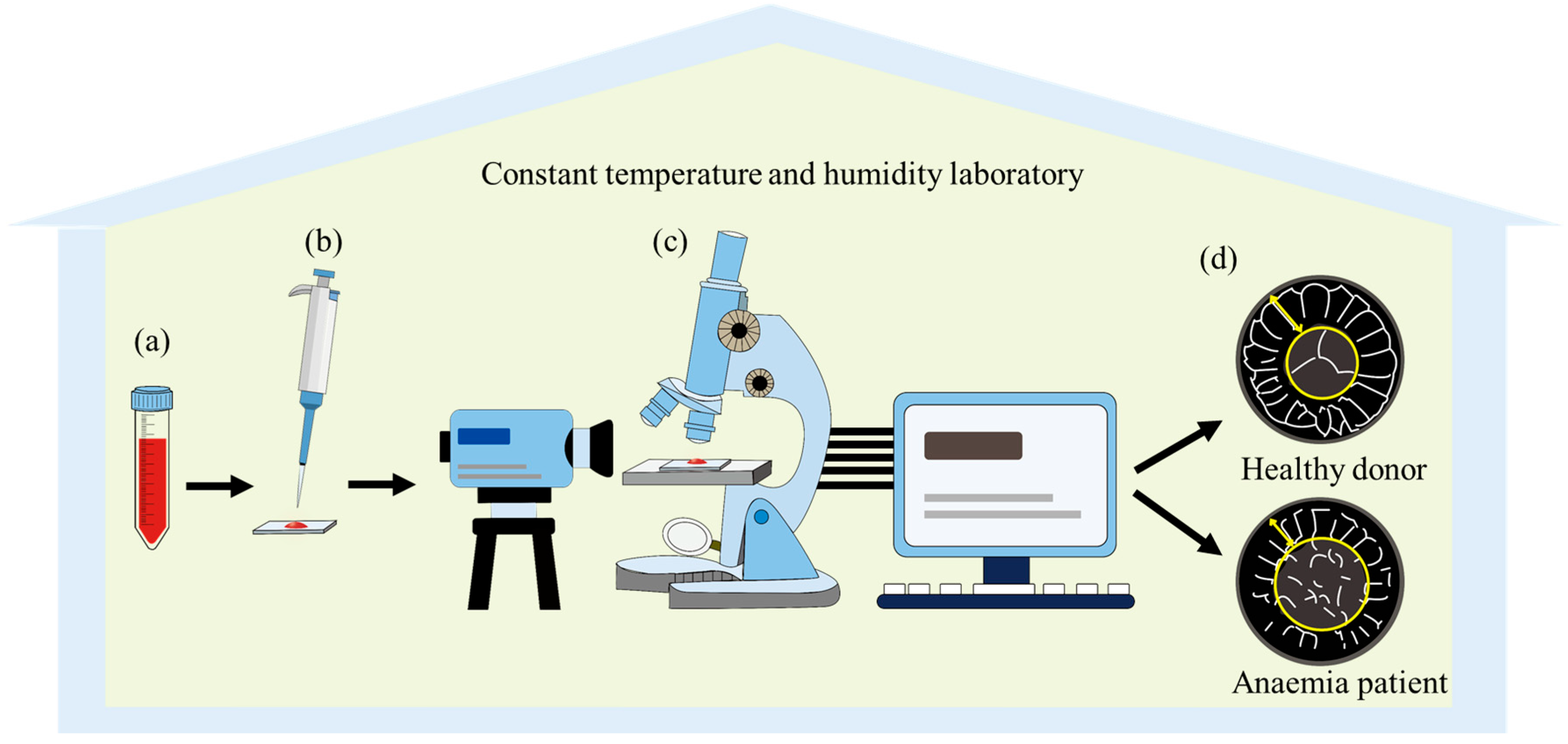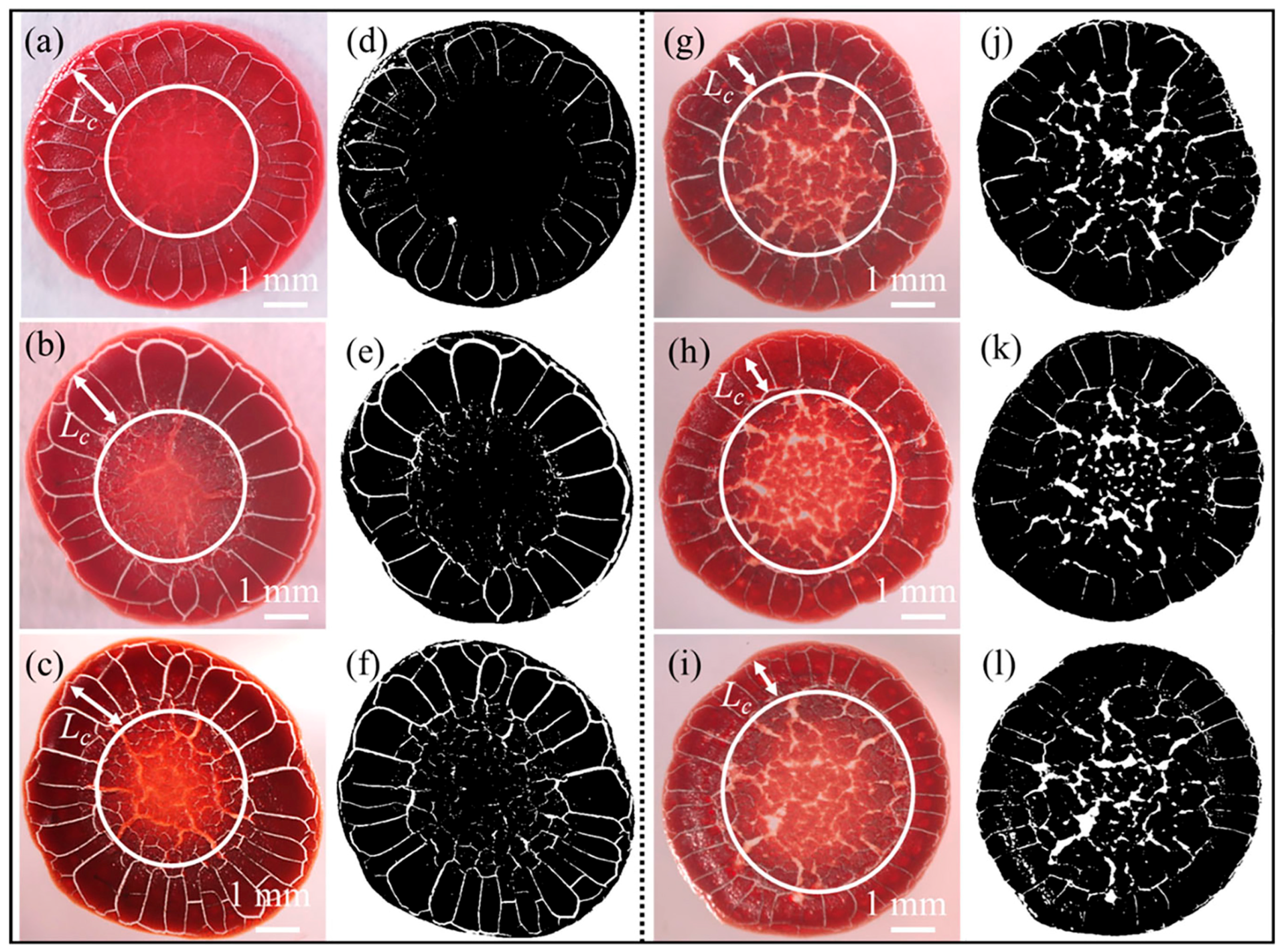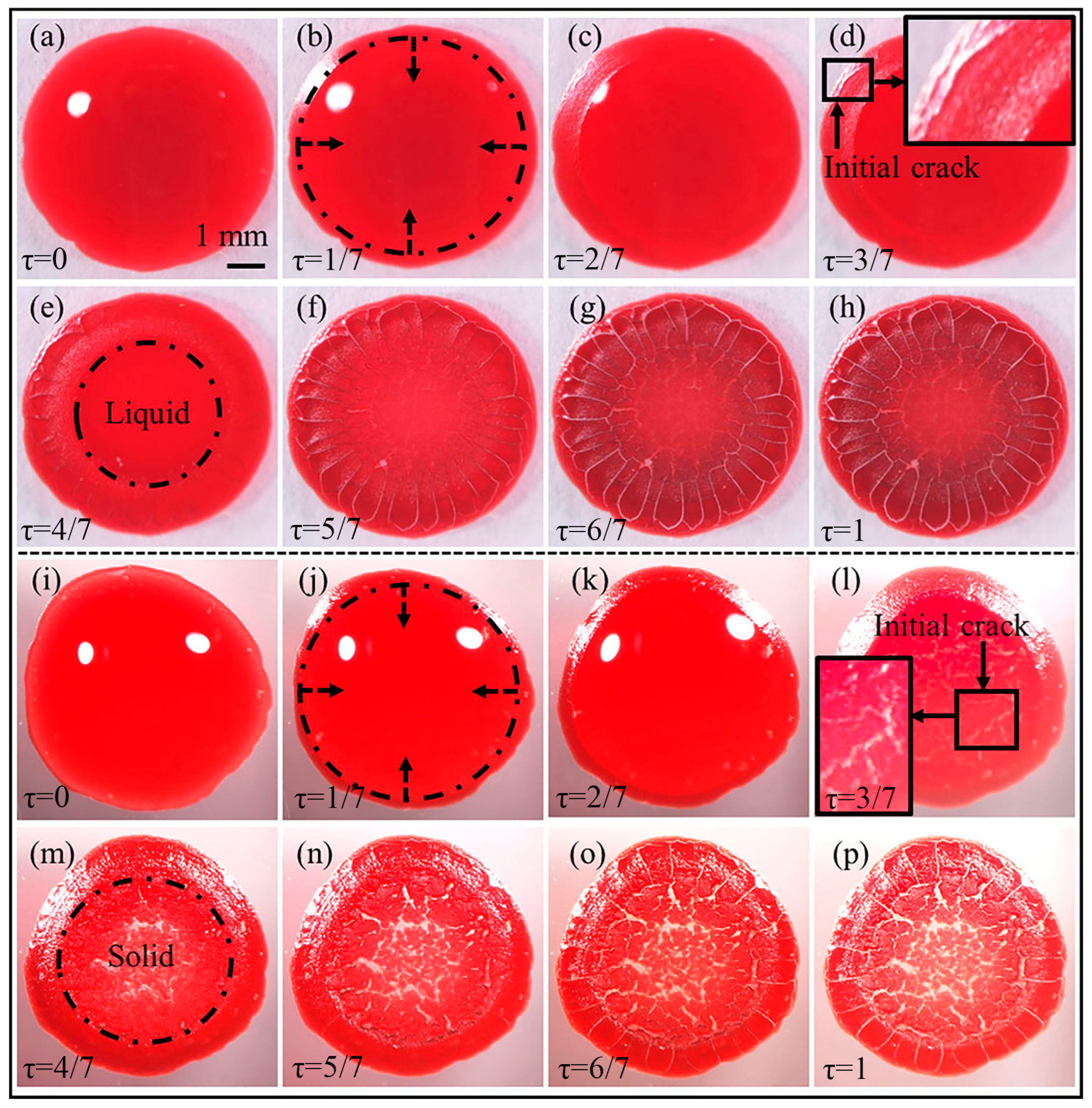A Point-of-Care Diagnostic Method Using Desiccation Patterns of Blood Sessile Droplets
Abstract
1. Introduction
2. Materials and Methods
3. Results and Discussion
3.1. Potential Diagnostic Observations
3.2. Differences in Morphological Evolution During Desiccation
3.3. Mechanistic Interpretation of Pattern Differences
4. Conclusions
Author Contributions
Funding
Institutional Review Board Statement
Data Availability Statement
Conflicts of Interest
References
- Wang, Z.; Orejon, D.; Takata, Y.; Sefiane, K. Wetting and evaporation of multicomponent droplets. Phys. Rep. 2022, 960, 1–37. [Google Scholar] [CrossRef]
- Brutin, D.; Starov, V. Recent advances in droplet wetting and evaporation. Chem. Soc. Rev. 2018, 47, 558–585. [Google Scholar] [CrossRef]
- Zang, D.; Tarafdar, S.; Tarasevich, Y.Y.; Dutta, C.M.; Dutta, T. Evaporation of a droplet: From physics to applications. Phys. Rep. 2019, 804, 1–56. [Google Scholar] [CrossRef]
- Kumar, B.; Chatterjee, S.; Agrawal, A.; Bhardwaj, R. Asymmetric deposits and crack formation during desiccation of a blood droplet on an inclined surface. Langmuir 2025, 41, 4c03767. [Google Scholar] [CrossRef]
- Sobac, B.; Brutin, D. Structural and evaporative evolutions in desiccating sessile drops of blood. Phys. Rev. E 2011, 84, 011603. [Google Scholar] [CrossRef] [PubMed]
- Sobac, B.; Brutin, D. Desiccation of a sessile drop of blood: Cracks, folds formation and delamination. Colloids Surf. A Physicochem. Eng. Asp. 2014, 448, 34–44. [Google Scholar] [CrossRef]
- Chen, R.; Zhang, L.; Zang, D.; Shen, W. Blood drop patterns: Formation and applications. Adv. Colloid Interface Sci. 2016, 231, 1–14. [Google Scholar] [CrossRef]
- Chen, R.; Zhang, L.; Zang, D.; Shen, W. Wetting and drying of colloidal droplets: Physics and pattern formation. Adv Colloid Sci. 2016, 1, 3–25. [Google Scholar] [CrossRef]
- Chen, R.; Zhang, L.; He, H.; Shen, W. Desiccation patterns of plasma sessile drops. ACS Sens. 2019, 4, 1701–1709. [Google Scholar] [CrossRef]
- Brutin, D.; Sobac, B.; Loquet, B.; Sampol, J. Pattern formation in drying drops of blood. J. Fluid Mech. 2011, 667, 85–95. [Google Scholar] [CrossRef]
- Bahmani, L.; Neysari, M.; Maleki, M. The study of drying and pattern formation of whole human blood drops and the effect of thalassaemia and neonatal jaundice on the patterns. Colloids Surf. A Physicochem. Eng. Asp. 2017, 513, 66–75. [Google Scholar] [CrossRef]
- Mukhopadhyay, M.; Ray, R.; Ayushman, M.; Sood, P.; Bhattacharyya, M.; Sarkar, D.; DasGupta, S. Interfacial energy driven distinctive pattern formation during the drying of blood droplets. J. Colloid Interface Sci. 2020, 573, 307–316. [Google Scholar] [CrossRef] [PubMed]
- Chen, R.; Zhang, L.; Zang, D.; Shen, W. Understanding desiccation patterns of blood sessile drops. J. Mater. Chem. B 2017, 5, 8991–8998. [Google Scholar] [CrossRef] [PubMed]
- Du, F.; Zhang, L.; Shen, W. The internal flow in an evaporating human blood plasma drop. J. Colloid Interface Sci. 2022, 609, 170–178. [Google Scholar] [CrossRef]
- Iqbal, R.; Shen, A.Q.; Sen, A.K. Understanding of the role of dilution on evaporative deposition patterns of blood droplets over hydrophilic and hydrophobic substrates. J. Colloid Interface Sci. 2020, 579, 541–550. [Google Scholar] [CrossRef]
- Brutin, D.; Sobac, B.; Nicloux, C. Influence of substrate nature on the evaporation of a sessile drop of blood. J. Heat Transf. 2012, 134, 061101. [Google Scholar] [CrossRef]
- Bou-Zeid, W.; Brutin, D. Effect of relative humidity on the spreading dynamics of sessile drops of blood. Colloids Surf. A Physicochem. Eng. Asp. 2014, 456, 273–285. [Google Scholar] [CrossRef]
- Bou Zeid, W.; Brutin, D. Influence of relative humidity on spreading, pattern formation and adhesion of a drying drop of whole blood. Colloids Surf. A Physicochem. Eng. Asp. 2013, 430, 1–7. [Google Scholar] [CrossRef]
- Chen, R.; Zhang, L.; Shen, W. Controlling the contact angle of biological sessile drops for study of their desiccated cracking patterns. J. Mater. Chem. B 2018, 6, 5867. [Google Scholar] [CrossRef]
- Pal, A.; Gope, A.; Sengupta, A. Drying of bio-colloidal sessile droplets: Advances, applications, and perspectives. Adv. Colloid Interface Sci. 2023, 314, 102870. [Google Scholar] [CrossRef]
- Jaber, A.; Vayron, R.; Harmand, S. Healthy and pathological porcine blood drop evaporation: Effect of the temperature. Langmuir 2023, 39, 4712–4719. [Google Scholar] [CrossRef] [PubMed]
- Goehring, L.; Nakahara, A.; Dutta, T.; Kitsunezaki, S.; Tarafdar, S. Desiccation Cracks and Their Patterns: Formation and Modelling in Science and Nature, 5th ed.; Wiley-VCH: Hoboken, NJ, USA, 2015; pp. 96–116. [Google Scholar] [CrossRef]





Disclaimer/Publisher’s Note: The statements, opinions and data contained in all publications are solely those of the individual author(s) and contributor(s) and not of MDPI and/or the editor(s). MDPI and/or the editor(s) disclaim responsibility for any injury to people or property resulting from any ideas, methods, instructions or products referred to in the content. |
© 2025 by the authors. Licensee MDPI, Basel, Switzerland. This article is an open access article distributed under the terms and conditions of the Creative Commons Attribution (CC BY) license (https://creativecommons.org/licenses/by/4.0/).
Share and Cite
He, H.; Xuan, L.; Lin, Y.; Zhang, M.; Mou, J.; Chen, R. A Point-of-Care Diagnostic Method Using Desiccation Patterns of Blood Sessile Droplets. Colloids Interfaces 2025, 9, 35. https://doi.org/10.3390/colloids9030035
He H, Xuan L, Lin Y, Zhang M, Mou J, Chen R. A Point-of-Care Diagnostic Method Using Desiccation Patterns of Blood Sessile Droplets. Colloids and Interfaces. 2025; 9(3):35. https://doi.org/10.3390/colloids9030035
Chicago/Turabian StyleHe, Hui, Lujia Xuan, Yihe Lin, Min Zhang, Junjie Mou, and Ruoyang Chen. 2025. "A Point-of-Care Diagnostic Method Using Desiccation Patterns of Blood Sessile Droplets" Colloids and Interfaces 9, no. 3: 35. https://doi.org/10.3390/colloids9030035
APA StyleHe, H., Xuan, L., Lin, Y., Zhang, M., Mou, J., & Chen, R. (2025). A Point-of-Care Diagnostic Method Using Desiccation Patterns of Blood Sessile Droplets. Colloids and Interfaces, 9(3), 35. https://doi.org/10.3390/colloids9030035









